| Home Brew 80/40 Meter Vertical Antenna I once own a butternut antenna and sold it. What a bad mistake that was! The butternut antenna I once own was a 5 band vertical and work really good considering I did not have any radials down, and did not have the space to put any down. Since I was lucky enough to have someone give me lots of aluminum stock, I decide to try my hand at building a mock up of a 80/40 meter version of a butternut antenna. So the search for information began. The internet is a great tool for information. I found website with manuals of different version of the butternut antenna. But what really grasp my attention was when I came across EI7BA website and read how he had re-work a butternut antenna he had. I began taking inventory to see what needed. All I was missing were some hose clamps and capacitors. Constructing The Vertical: The total height of this antenna is 33 FT. So lets get started. Step 1: All of my 1" OD tubing is 11 FT in length. Starting with the bottom section of the antenna, a piece of 11 foot aluminum tubing was cut down to 6'. This is different from the original version. Next is the first upper section which is also a 1" OD tubing and kept at its original 11' height. When building yours, you may need to make some adjustment to achieve 11 feet. When purchasing aluminum tubing by mail. There usually only ship in 8' section. In that case you'll be able to get aluminum stock that will inter-lock with each other. I had a little bit of a problem with mine. I'll explain more later. Step 2: Now you'll need to join the 6' section and the first upper 11' section together and at the same time not have the two section make electrical contact with each other. How I achieve this was I used what I had on hand. I used a peace of 1/2 PVC tubing cut 8" inch long. Inserting 4" of the PVC tubing into the 6' section and 4" into the 11' section leaving a 1 inch spacing between the to. Then drilling a hole on each end of the tubing and making sure they line up with each other. I then inserted a 1 1/2 brass screw with nuts and washers to lock it in place. Now to make it a bit stronger. I cut a peace of 1" ID PVC tubing 10" long. Using a hawk saw I split the tubing down the middle. Only cutting one side of the PVC tubing and taking out about 1/4 inch of it. The reason for splitting the 1" ID PVC tubing was so that I could slip this over 1" OD aluminum tubing and around the screws that I put in place to hold the 1/2" PVC tubing that was inserted in the inside of the two section. Here's a picture of what I'm talking about Fig 1 (Click here). You should have a total height of about 18 feet which includes the 1 inch spacing between the lower 6 foot section and the upper 11 foot section. From this point on if you have tubing that will inter-lock with each other then continue on installing the tubing to get your full length of 33 feet and making sure to use hose clamps to fasten each section together. I did not have the correct size tubing to fit inside the 1" OD tubing I had. So to make this work this is what I did to make up the 15 feet I would have been short. This picture will show and tell you what I did (CLICK HERE) . Step 3: The Coils: Now for the 80/40 meter coils. The coils were make from 1/4 aluminum tubing that I had, I sure you could use copper and get away with it if that's all you have on had. The coils have a ID of 4" inches. I used a 1 quart paint can that measure about 4 1/4 inch or so round, Close winding the 1/4 tubing around the paint can with 18 turns made up the 80 meter coil. Doing the same process 10 turns of the 1/4 inch round tubing made up the 40 meter coil. You will had to bend the ends a little when time to fasten the coils to the tubing and using hose clamps to fasten them in place. Here's a picture of the coil (Click Here). Step 4: The Capacitor Plate: Making the capacitor plate. Here again I used what ever scrapes of material I had laying around. I had a peace of 1/2" wide heavy aluminum about 3' long which I bent and molded into shape using a vise. This was used to hold the 200pf 7.5 kv door knob capacitor and the 68pf 7.5 kv capacitor in place. At the time of construction mid summer of 2007 I only had the 68pf capacitor which you'll see from the first picture. As of today December 13, 2008 I'm updating this page and will be making adjustments to the antenna soon. I have purchase two 100pf 5 kv capacitors. And my capacitor bracket will be modified. Yes its a bit cold outside now. Click here to view picture and more information. Step 5: Antenna Mounting Bracket: Ground mounting the antenna. I had a 5' section of fence piping about 1 1/2" OD. I drove two feet of this into the ground. From a peace of scrap plywood I then cut a 12x12 section out. And then drill two sets of holes in order to mount the plywood to the fence pipe with u-bolts. And then another set of holes were drill to hold the bottom 6' section of the antenna to the plywood. The plywood was weather coated with about 6 coats of polyurethane in order to protect it from the weather. When ever I need to lower the antenna all I have to do is take out the bolt that holding the antenna in place and it can be lower to the ground. Here's a picture of the bracket... Now lets see how this baby holds up this coming weather 2007- 2008 Note: I added 9 ground radials. Plus the ground system is tied into a 40 foot chain link fence. Don't know if the fence is helping. And being that I have a small city lot that's the best I can do as far as a ground radial system goes. Tuning The Antenna: Tuning this antenna was a big pain in the (Butt). Running in and out of the shack to the rig to the antenna. After an hour of this I stop. I then broke down and purchase a MFJ-259B antenna analyzer. Yes the analyzer was a little costly for one project. But I had plans on building some other antenna. So it will come in handy. Still working on the tuning of this antenna. Will report my finings as I go. I'm not happy with my swr and having lots of rfi problems. ************************************************************************************* Noisy Band: 80/40 meters are very noisy bands to work at my location. My noise level most of the time is S7 - 9 until very late in the night it my drop down to a S5. I have a neighbor who a ham and lives at the other end of the block from me. He works mostly 75 meters using a Carolina Windom antenna. He tell me that he does not have the same noise level as I. Now figure out why ? Up Dated December 13, 2008 noisy band conduction. Well after playing with the antenna on and off. I have figure out part of my noise problem, and what I can do to solve and or correct it if at all. I must mention that this noise problem only affects 40, 80 and 160 meter bands. I do not have an antenna for 160 but do listen from time to time. 1.) Listing on the vertical is still very noisy. So what I've tried doing is using my 20 meter loop antenna as a receiving antenna for 75 meters. What I've come to fine out is that the 75 meter band is much quieter to listen to using the loop. The noise level on the vertical is a S-7 to S-9. On the loop antenna the noise level is anywhere from a S-0 to S-3 -4 most of the time unless band condition are really bad. My loop antenna is just about 25 feet off the ground. So I will do one of two things. Either build another loop just for receiving. Or use this loop antenna after I build my 5 band Hex Beam. And then build a switching relay system. So that when I transmit the relay switches over the vertical antenna and when not transmit it switches back to the loop. 2.) The second thing I've come to fine out is that my computers are causing some RFI problems into my receiver. Here's just a few things I've done so far that has help. Using snap on ferrite core I place two on my hard drive cable. Now when ever my hard drive is running I no longer hear it in my receiver. But I still have so problem that I'm working on. 3.) Cordless devices. I have a cordless mouse that is generating noise into my receiver. I warp the cable around two snap on ferrite core and that took care of that. ************************************************************************************* First contact on 40 meters was with WT8E and received a signal report of 55. The same goes for 80 meters. A 55 report with a Delaware station and a up state New York. Credit For This Project goes to EI7BA. For more technical information has to how it all works visit John's website. Thanks much John for the nice website and emailing me 73's. 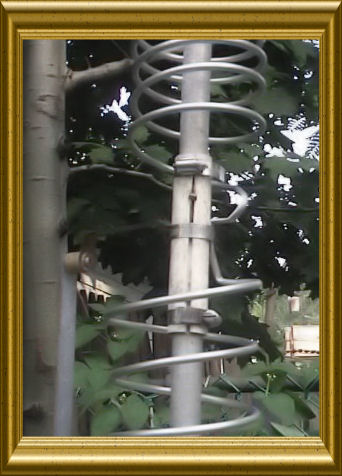 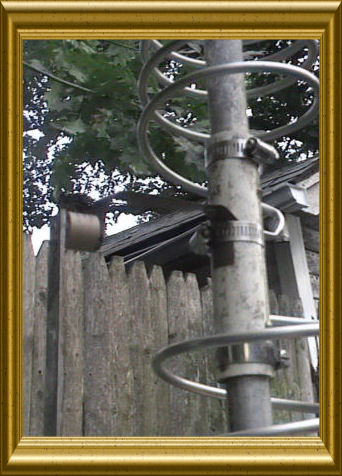 The picture to the right shows the lower coil which is for 80 meters, the upper is 40 meters. The bottom section of aluminum tubing is 6 feet and the first upper section is a 11 foot section of 1 inch tubing being supported with a 1/2 of pvc tubing in the center that is lock in place with two brass screw if you look closely. Then there is a 1 inch piece of pvc tubing on the out side with hose clamps that holds this all together. To the right is another view of how its heal together. You'll also notice the capacitor and home made strapping. The antenna has seen very high winds its rock and roll but has not come down. Antenna was put up in 2006 as of today Sept 12, 2008 it's still standing. 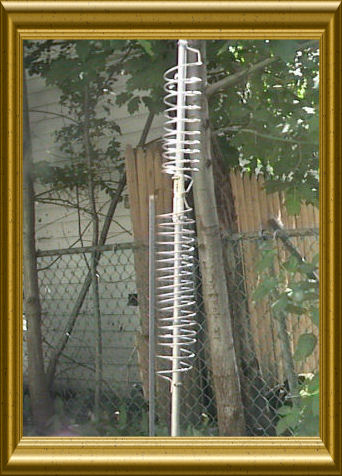 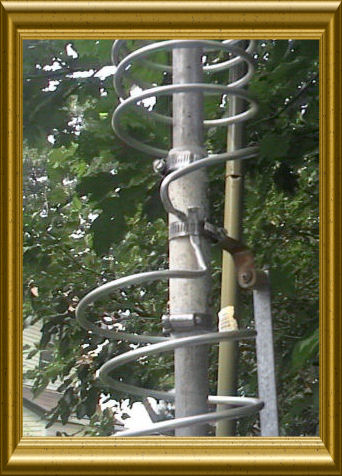 Picture above to the right and left are another view of the 80/40 meter coils 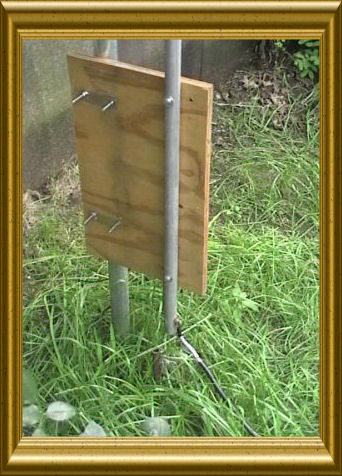 Here's how I mounted the vertical antenna. I can un-screw the top bolt and lower the antenna for maintains if needed. 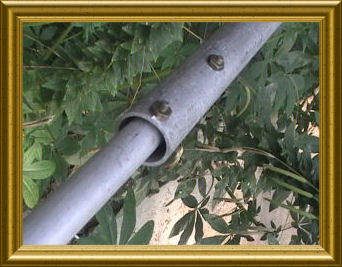 This is the upper section of the 11 foot aluminum tubing with the remaining 17 feet of smaller tubing attach to it to make the total of 33 feet for this antenna. I did not have the correct size tubing to fit inside the 1 inch tubing. So with some nuts and washer place on the inside I manage to get it center. From the ground looking up you would never know it was attach. All I can say is it works. Up Date: April 2008. The 40 meter section of this antenna works the best for me right now. Still trying to get the 80 meters section to resonate in a portion of the cw/sbb. Well the only way I've been able to achieve that was. A friend load me his MFJ 989C antenna tuner. I know have been able to tune all of the 80 meter band. After doing some other testing, I was surprise to fine out that I was also able to tune 30 meter, 17 meters. And a couple of other bands. I think this tuner could tuner a shoe string if I tried hard enough. I work the following station on 80 meters during a rtty contest in March 2008. VA2UP, OK2FSP, OK3R, 7XORY, XE2YBG, DL8SCG, EA5XE, CO4LS, S51MA, and that's just to name a few. This antenna seem to work its best at Dxing or distance state side stations. I've log lots of station on 40 meters... Not to bad for a first timers home made butternut antenna. |
Saturday, February 25, 2012
Home Brew 80/40 Meter Vertical Antenna
Subscribe to:
Post Comments (Atom)

No comments:
Post a Comment